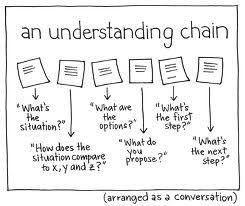Understanding Chain
Communicating clearly and effectively is a challenge when there is a lot to say to a lot of people. It can be tempting to try to explain everything at once to an audience and fail in the process.
In the Understanding Chain activity, a group shifts from a content focus to an audience focus, and draws out a meaningful, linear structure for communication.

To set up the activity, the group needs to develop two things: an audience breakdown and a set of questions
The audience(s): If there are a large number of audiences, break them down into meaningful groups. The groups could be as broad as “my team” or as specific as “the guys in IT who fix the laptops.” As a rule of thumb, the more specific the audience, the more tailored and effective the understanding chain will be. Each audience group will need its own understanding chain.
The questions: Once the group has a clear picture of their audience, it’s time to brainstorm questions. The questions frame what people really want to know and care about. Questions are best captured in the voice or thoughts of the audience, as they would ask them. The questions will become links in the understanding chanin.
To generate them, the group puts itself in the mindset of the audience and captures the questions on individual sticky notes. The activity begins by sorting questions in a horizontal line on a sticky wall. This is the timeline of a communication, from beginning to end.
The group may arrange the questions as a conversation. In this chain the group thinks thorugh a conversation with the audience and arranges the questions in an order that flows naturally. Although all conversations are different, one framework to consider is;
- Connecting: What’s up? What do We have in Common?
- Focusing: What’s important right now? What do you know about it?
- Acting: What should we do?
An understanding chain, like any chain is only as strong as its weakest link. By examining the questions as whole, has the group uncovered an area that needs work or found any ‘tough questions’ that are not easy to answer.
A group that tackles the weak questions and has the courage to answer the tough ones directly and honestly will win.

